rear view mirror BMW M6 CONVERTIBLE 2015 F12M Owner's Manual
[x] Cancel search | Manufacturer: BMW, Model Year: 2015, Model line: M6 CONVERTIBLE, Model: BMW M6 CONVERTIBLE 2015 F12MPages: 230, PDF Size: 4.9 MB
Page 21 of 230

Dynamic Damping Control‚ÄÇ‚ÄÖ132Servotronic‚ÄÇ‚ÄÖ13213Transmission selector lever
All around the interior rearview mirror
1Intelligent Emergency Re‚Äê
quest‚ÄÇ‚ÄÖ 2002Reading lights‚ÄÇ‚ÄÖ 1053Interior lights‚ÄÇ‚ÄÖ1044Indicator lamp, front-seat pas‚Äê
senger airbag‚ÄÇ‚ÄÖ 108Seite 17CockpitAt a glance17
Online Edition for Part no. 01 40 2 959 664 - II/15
Page 40 of 230

vated. All settings stored in the profile are au‚Äê
tomatically applied.
If several drivers use their own remote control,
the vehicle will adjust the personal settings
during unlocking. These settings are also re‚Äê
stored, if the vehicle has been used in the
meantime by a person with a different remote
control.
Changes to the settings are automatically
saved in the personal profile.
Three personal profiles and a guest profile can
be created.
Adjusting
The settings for the following systems and
functions are saved in the active profile. The
scope of storable settings is country- and
equipment-dependable.‚ñ∑Unlocking and locking.‚ñ∑Lights.‚ñ∑Climate control.‚ñ∑Radio.‚ñ∑Instrument cluster.‚ñ∑Programmable memory buttons.‚ñ∑Volumes, tone.‚ñ∑Control Display.‚ñ∑Navigation.‚ñ∑TV.‚ñ∑Park Distance Control PDC.‚ñ∑Rearview camera‚ñ∑Side View.‚ñ∑Head-up Display.‚ñ∑M Drive: configurations.‚ñ∑Driver's seat position, exterior mirror posi‚Äê
tion, steering wheel position.‚ñ∑Intelligent Safety.‚ñ∑Active Blind Spot Detection.‚ñ∑Night vision.Profile management
Opening profiles Regardless of the remote control in use a dif‚Äê
ferent profile may be activated.1."Settings"2."Profiles"3.Select a profile.‚ñ∑All settings stored in the called-up profile
are automatically applied.‚ñ∑The called-up profile is assigned to the re‚Äê
mote control being used at the time.‚ñ∑If the profile is already assigned to a differ‚Äê
ent remote control, this profile will apply to
both remote controls. It cannot be differen‚Äê
tiated anymore between the settings for
the two remote controls.
Renaming profiles
A personal name can be assigned to every pro‚Äê
file to avoid confusion between the profiles.
1."Settings"2."Profiles"3."Options"4."Rename current profile"
Resetting profiles
The settings of the active profile are reset to
their default values.
1."Settings"2."Profiles"3."Options"4."Reset current profile"
Exporting profiles
Most settings of the active profile can be ex‚Äê
ported.
This can be helpful for securing and retrieving
personal settings, before delivering the vehicle
to a workshop, e.g. Profiles can be taken to an‚Äê
Seite 36ControlsOpening and closing36
Online Edition for Part no. 01 40 2 959 664 - II/15
Page 49 of 230
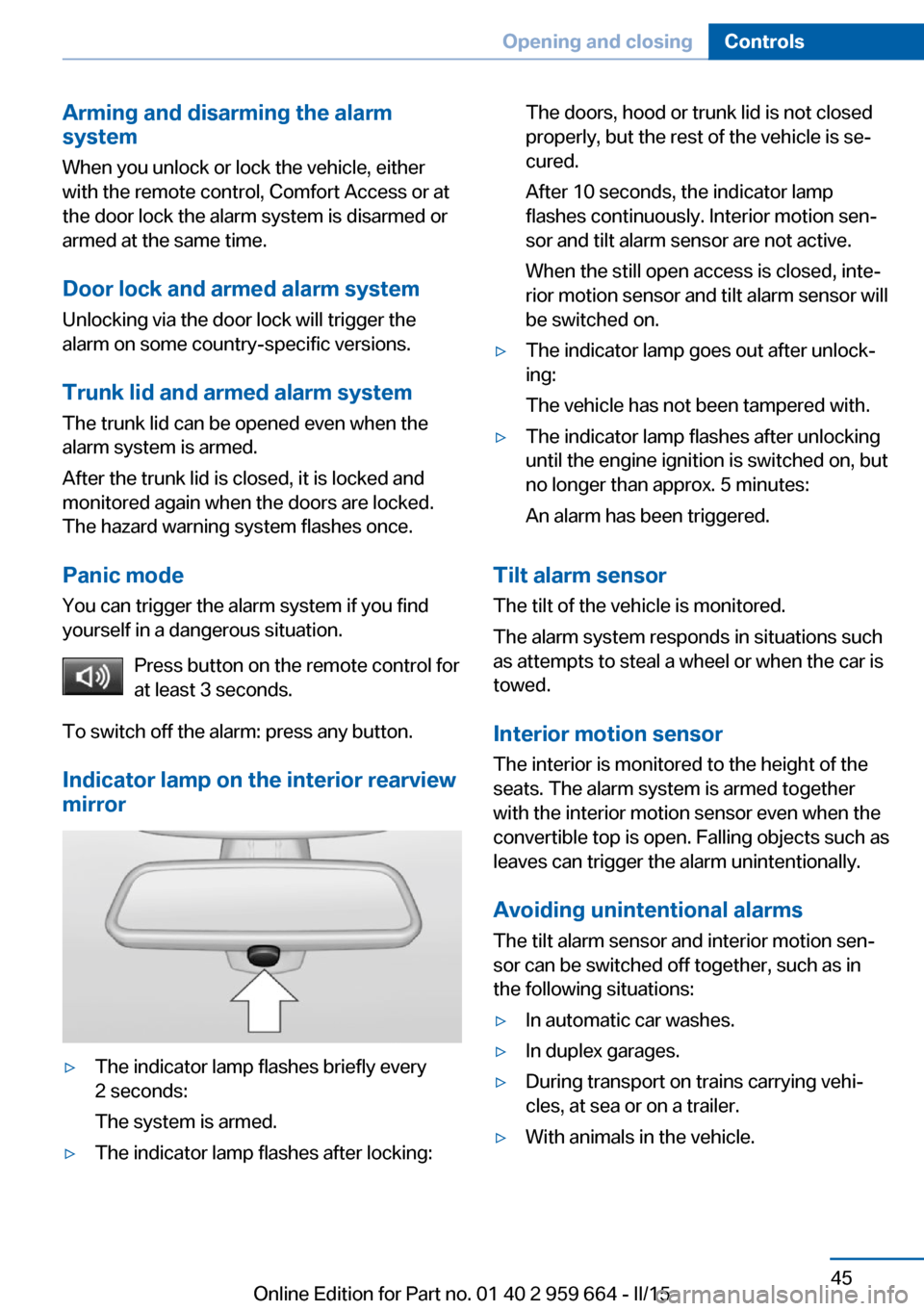
Arming and disarming the alarm
system
When you unlock or lock the vehicle, either
with the remote control, Comfort Access or at
the door lock the alarm system is disarmed or
armed at the same time.
Door lock and armed alarm systemUnlocking via the door lock will trigger the
alarm on some country-specific versions.
Trunk lid and armed alarm system The trunk lid can be opened even when the
alarm system is armed.
After the trunk lid is closed, it is locked and
monitored again when the doors are locked.
The hazard warning system flashes once.
Panic mode
You can trigger the alarm system if you find
yourself in a dangerous situation.
Press button on the remote control for
at least 3 seconds.
To switch off the alarm: press any button.
Indicator lamp on the interior rearview
mirror‚ñ∑The indicator lamp flashes briefly every
2 seconds:
The system is armed.‚ñ∑The indicator lamp flashes after locking:The doors, hood or trunk lid is not closed
properly, but the rest of the vehicle is se‚Äê
cured.
After 10 seconds, the indicator lamp
flashes continuously. Interior motion sen‚Äê
sor and tilt alarm sensor are not active.
When the still open access is closed, inte‚Äê
rior motion sensor and tilt alarm sensor will
be switched on.‚ñ∑The indicator lamp goes out after unlock‚Äê
ing:
The vehicle has not been tampered with.‚ñ∑The indicator lamp flashes after unlocking
until the engine ignition is switched on, but
no longer than approx. 5 minutes:
An alarm has been triggered.
Tilt alarm sensor The tilt of the vehicle is monitored.
The alarm system responds in situations such
as attempts to steal a wheel or when the car is
towed.
Interior motion sensor The interior is monitored to the height of the
seats. The alarm system is armed together
with the interior motion sensor even when the
convertible top is open. Falling objects such as
leaves can trigger the alarm unintentionally.
Avoiding unintentional alarms The tilt alarm sensor and interior motion sen‚Äê
sor can be switched off together, such as in
the following situations:
‚ñ∑In automatic car washes.‚ñ∑In duplex garages.‚ñ∑During transport on trains carrying vehi‚Äê
cles, at sea or on a trailer.‚ñ∑With animals in the vehicle.Seite 45Opening and closingControls45
Online Edition for Part no. 01 40 2 959 664 - II/15
Page 68 of 230
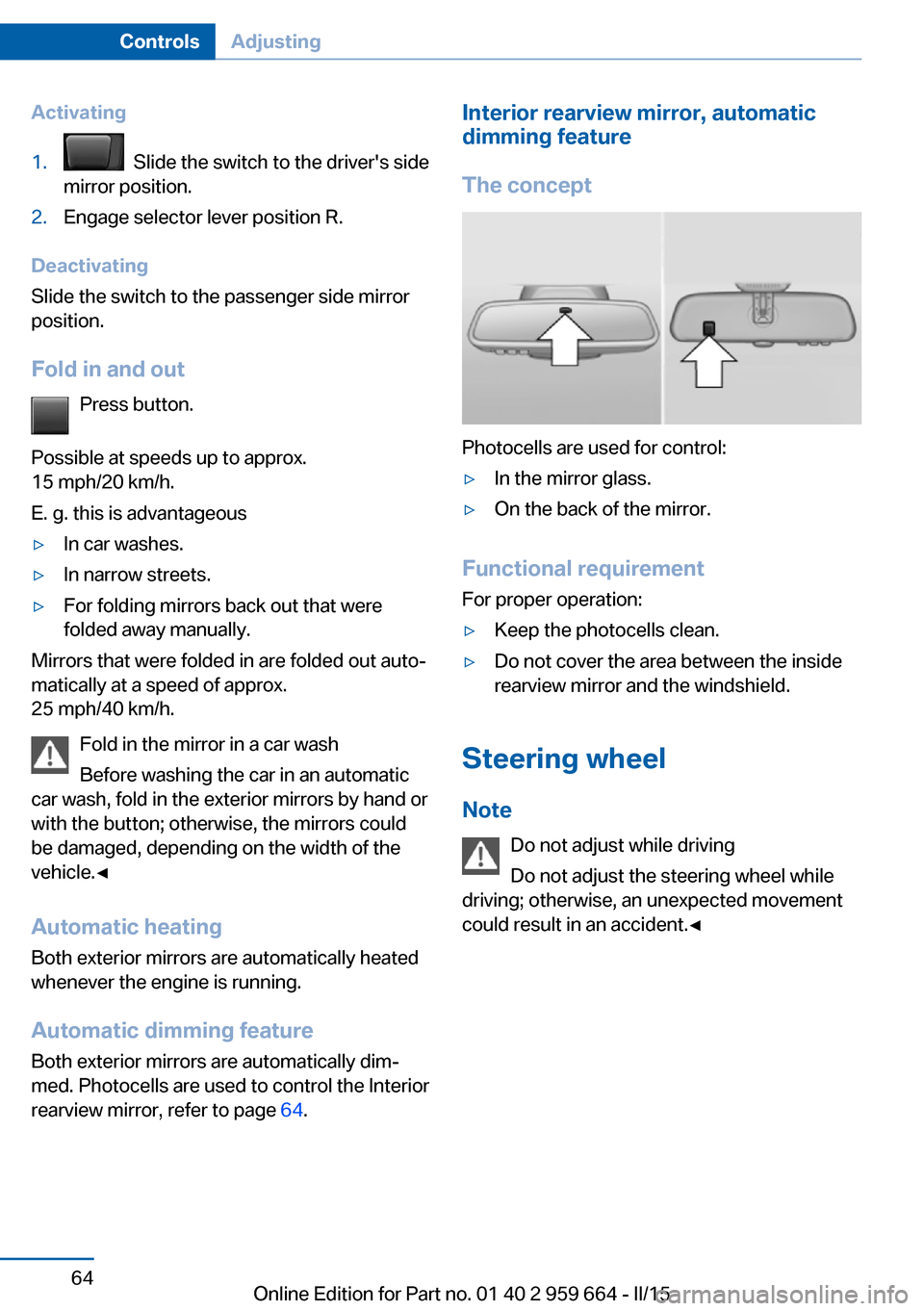
Activating1. Slide the switch to the driver's side
mirror position.2.Engage selector lever position R.
Deactivating
Slide the switch to the passenger side mirror
position.
Fold in and out Press button.
Possible at speeds up to approx.
15 mph/20 km/h.
E. g. this is advantageous
‚ñ∑In car washes.‚ñ∑In narrow streets.‚ñ∑For folding mirrors back out that were
folded away manually.
Mirrors that were folded in are folded out auto‚Äê
matically at a speed of approx.
25 mph/40 km/h.
Fold in the mirror in a car wash
Before washing the car in an automatic
car wash, fold in the exterior mirrors by hand or
with the button; otherwise, the mirrors could
be damaged, depending on the width of the
vehicle.‚óÄ
Automatic heating
Both exterior mirrors are automatically heated
whenever the engine is running.
Automatic dimming feature Both exterior mirrors are automatically dim‚Äê
med. Photocells are used to control the Interior
rearview mirror, refer to page 64.
Interior rearview mirror, automatic
dimming feature
The concept
Photocells are used for control:
‚ñ∑In the mirror glass.‚ñ∑On the back of the mirror.
Functional requirement For proper operation:
‚ñ∑Keep the photocells clean.‚ñ∑Do not cover the area between the inside
rearview mirror and the windshield.
Steering wheel
Note Do not adjust while driving
Do not adjust the steering wheel while
driving; otherwise, an unexpected movement
could result in an accident.‚óÄ
Seite 64ControlsAdjusting64
Online Edition for Part no. 01 40 2 959 664 - II/15
Page 97 of 230

DisplaysSymbolDescriptionShift up to fuel efficient gear.Shift down to fuel efficient gear.
Speed limit detection
The concept
Speed limit detection
Speed limit detection uses a symbol in the
shape of a traffic sign to display the currently
detected speed limit. The camera in the area of
the interior rearview mirror detects traffic signs
at the edge of the road as well as variable over‚Äê
head sign posts. Traffic signs with extra sym‚Äê
bols for wet road conditions, etc. are also de‚Äê
tected and compared with the vehicle's
onboard data, such as for the rain sensor, and
will be displayed depending on the situation.
The system takes into account the information
stored in the navigation system and also dis‚Äê
plays speed limits present on routes without
signs.
Hints Personal judgment
The system cannot serve as a substitute
for the driver's personal judgment of the traffic
situation.
The system assists the driver and does not re‚Äê
place the human eye.‚óÄ
At a glance
Camera
The camera is found near the interior rearview
mirror.
Keep the windshield in the area behind the in‚Äê
terior rearview mirror clean and clear.
Switching on/offOn the Control Display:
1."Settings"2."Instrument cluster"3."Speed limit information"
If speed limit detection is switched on, it can
be displayed on the info display in the instru‚Äê
ment cluster via the computer.
Display The following is displayed in the instrument
cluster:
Speed limit detection Current speed limit.
Speed limit detection is not available.
Seite 93DisplaysControls93
Online Edition for Part no. 01 40 2 959 664 - II/15
Page 98 of 230

Speed limit detection can also be displayed in
the Head-up Display.
System limits The system may not be fully functional and
may provide incorrect information in the fol‚Äê
lowing situations:‚ñ∑In heavy fog, rain or snowfall.‚ñ∑When signs are concealed by objects.‚ñ∑When driving very close to the vehicle in
front of you.‚ñ∑When driving toward bright lights.‚ñ∑When the windshield behind the interior
rearview mirror is fogged over, dirty or cov‚Äê
ered by a sticker, etc.‚ñ∑In the event of incorrect detection by the
camera.‚ñ∑If the speed limits stored in the navigation
system are incorrect.‚ñ∑In areas not covered by the navigation sys‚Äê
tem.‚ñ∑When roads differ from the navigation,
such as due to changes in road routing.‚ñ∑When passing buses or trucks with a
speed sticker.‚ñ∑If the traffic signs are non-conforming.‚ñ∑During calibration of the camera immedi‚Äê
ately after vehicle shipment.
Selection lists in the
instrument cluster
The concept Depending on your vehicle's optional features,
the following can be displayed or operated us‚Äê
ing the buttons and the thumbwheel on the
steering wheel as well as the displays in the in‚Äê
strument cluster and the Head-up Display:
‚ñ∑Current audio source.‚ñ∑Redial phone feature.‚ñ∑Turn on voice activation system.
Display
Depending on your vehicle's optional features,
the list in the instrument cluster can differ from
the illustration shown.
Activating a list and adjusting the
setting
On the right side of the steering wheel, turn
the thumbwheel to activate the corresponding
list.
Using the thumbwheel, select the desired set‚Äê
ting and confirm it by pushing the thumbwheel.
On-board computer
Indication in the info display The information from the com‚Äê
puter is shown in the info display
in the instrument cluster.
Seite 94ControlsDisplays94
Online Edition for Part no. 01 40 2 959 664 - II/15
Page 107 of 230
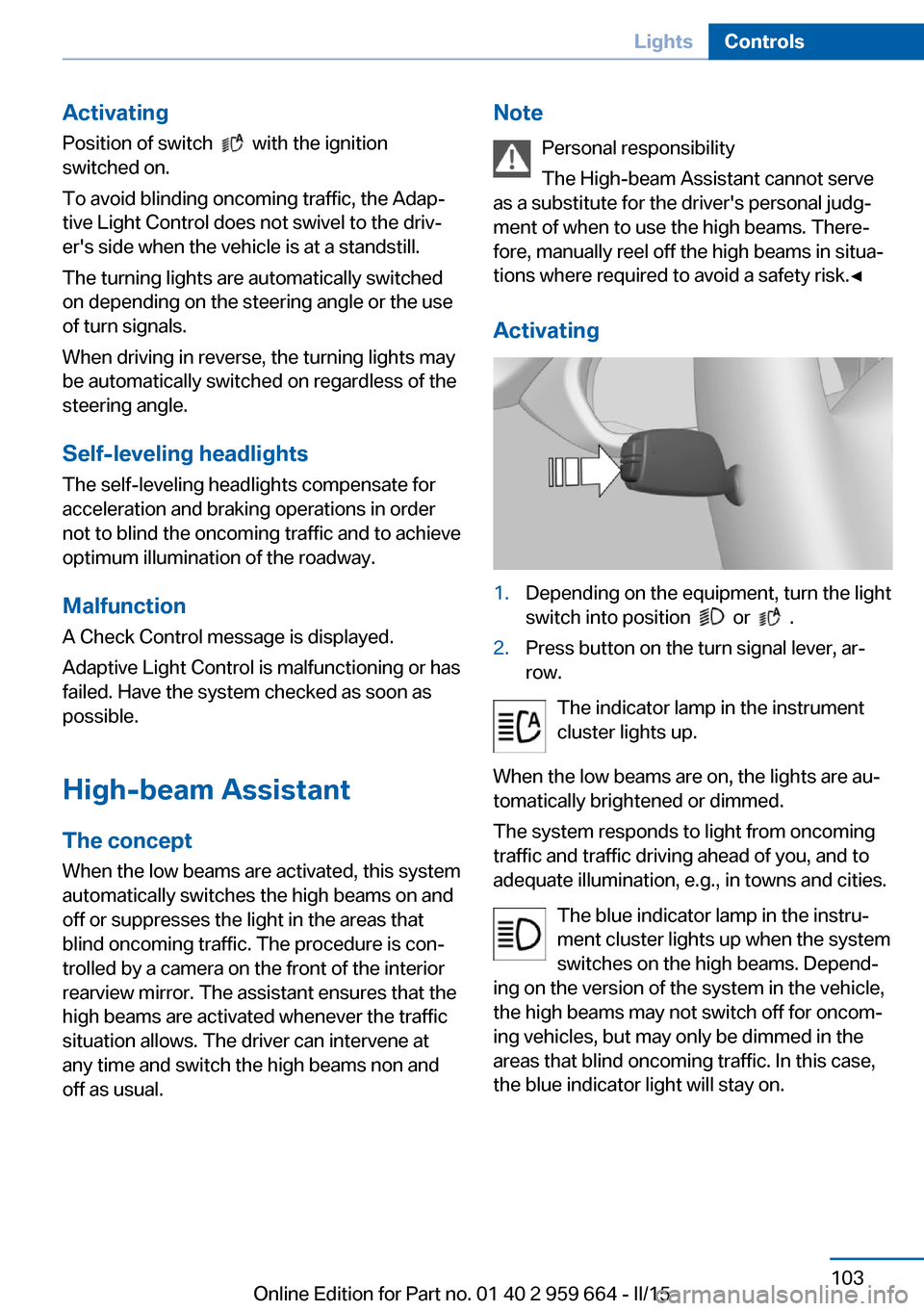
ActivatingPosition of switch
with the ignition
switched on.
To avoid blinding oncoming traffic, the Adap‚Äê
tive Light Control does not swivel to the driv‚Äê
er's side when the vehicle is at a standstill.
The turning lights are automatically switched
on depending on the steering angle or the use
of turn signals.
When driving in reverse, the turning lights may
be automatically switched on regardless of the
steering angle.
Self-leveling headlights The self-leveling headlights compensate for
acceleration and braking operations in order
not to blind the oncoming traffic and to achieve
optimum illumination of the roadway.
Malfunction A Check Control message is displayed.
Adaptive Light Control is malfunctioning or has
failed. Have the system checked as soon as
possible.
High-beam Assistant
The concept When the low beams are activated, this system
automatically switches the high beams on and
off or suppresses the light in the areas that
blind oncoming traffic. The procedure is con‚Äê
trolled by a camera on the front of the interior
rearview mirror. The assistant ensures that the
high beams are activated whenever the traffic
situation allows. The driver can intervene at
any time and switch the high beams non and
off as usual.
Note
Personal responsibility
The High-beam Assistant cannot serve
as a substitute for the driver's personal judg‚Äê
ment of when to use the high beams. There‚Äê
fore, manually reel off the high beams in situa‚Äê
tions where required to avoid a safety risk.‚óÄ
Activating1.Depending on the equipment, turn the light
switch into position
or .
2.Press button on the turn signal lever, ar‚Äê
row.
The indicator lamp in the instrument
cluster lights up.
When the low beams are on, the lights are au‚Äê
tomatically brightened or dimmed.
The system responds to light from oncoming
traffic and traffic driving ahead of you, and to
adequate illumination, e.g., in towns and cities.
The blue indicator lamp in the instru‚Äê
ment cluster lights up when the system
switches on the high beams. Depend‚Äê
ing on the version of the system in the vehicle, the high beams may not switch off for oncom‚Äê
ing vehicles, but may only be dimmed in the
areas that blind oncoming traffic. In this case,
the blue indicator light will stay on.
Seite 103LightsControls103
Online Edition for Part no. 01 40 2 959 664 - II/15
Page 108 of 230
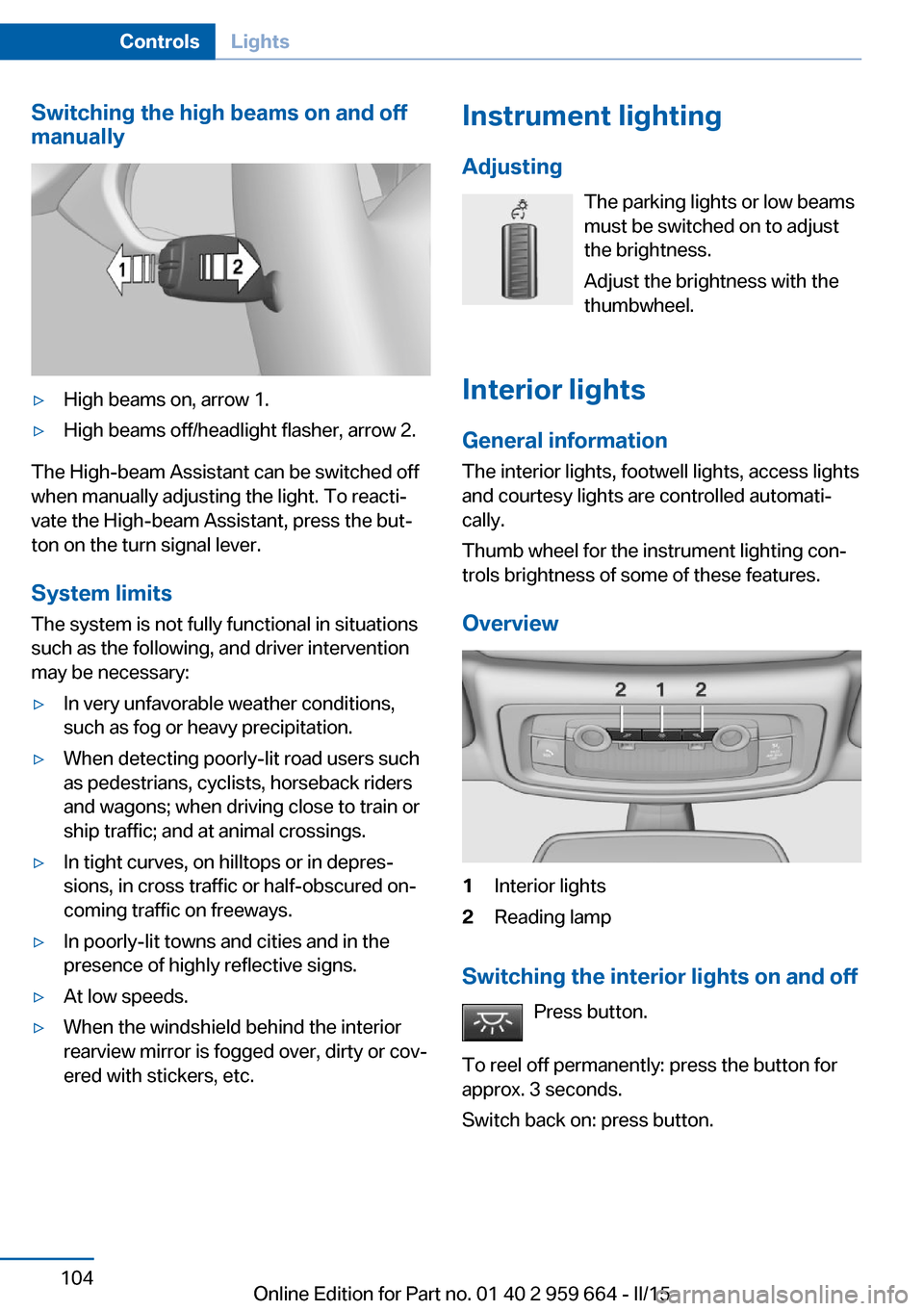
Switching the high beams on and off
manually‚ñ∑High beams on, arrow 1.‚ñ∑High beams off/headlight flasher, arrow 2.
The High-beam Assistant can be switched off
when manually adjusting the light. To reacti‚Äê
vate the High-beam Assistant, press the but‚Äê
ton on the turn signal lever.
System limits
The system is not fully functional in situations such as the following, and driver intervention
may be necessary:
‚ñ∑In very unfavorable weather conditions,
such as fog or heavy precipitation.‚ñ∑When detecting poorly-lit road users such
as pedestrians, cyclists, horseback riders
and wagons; when driving close to train or
ship traffic; and at animal crossings.‚ñ∑In tight curves, on hilltops or in depres‚Äê
sions, in cross traffic or half-obscured on‚Äê
coming traffic on freeways.‚ñ∑In poorly-lit towns and cities and in the
presence of highly reflective signs.‚ñ∑At low speeds.‚ñ∑When the windshield behind the interior
rearview mirror is fogged over, dirty or cov‚Äê
ered with stickers, etc.Instrument lighting
Adjusting The parking lights or low beams
must be switched on to adjust
the brightness.
Adjust the brightness with the
thumbwheel.
Interior lights
General information
The interior lights, footwell lights, access lights
and courtesy lights are controlled automati‚Äê
cally.
Thumb wheel for the instrument lighting con‚Äê
trols brightness of some of these features.
Overview1Interior lights2Reading lamp
Switching the interior lights on and off Press button.
To reel off permanently: press the button for
approx. 3 seconds.
Switch back on: press button.
Seite 104ControlsLights104
Online Edition for Part no. 01 40 2 959 664 - II/15
Page 118 of 230
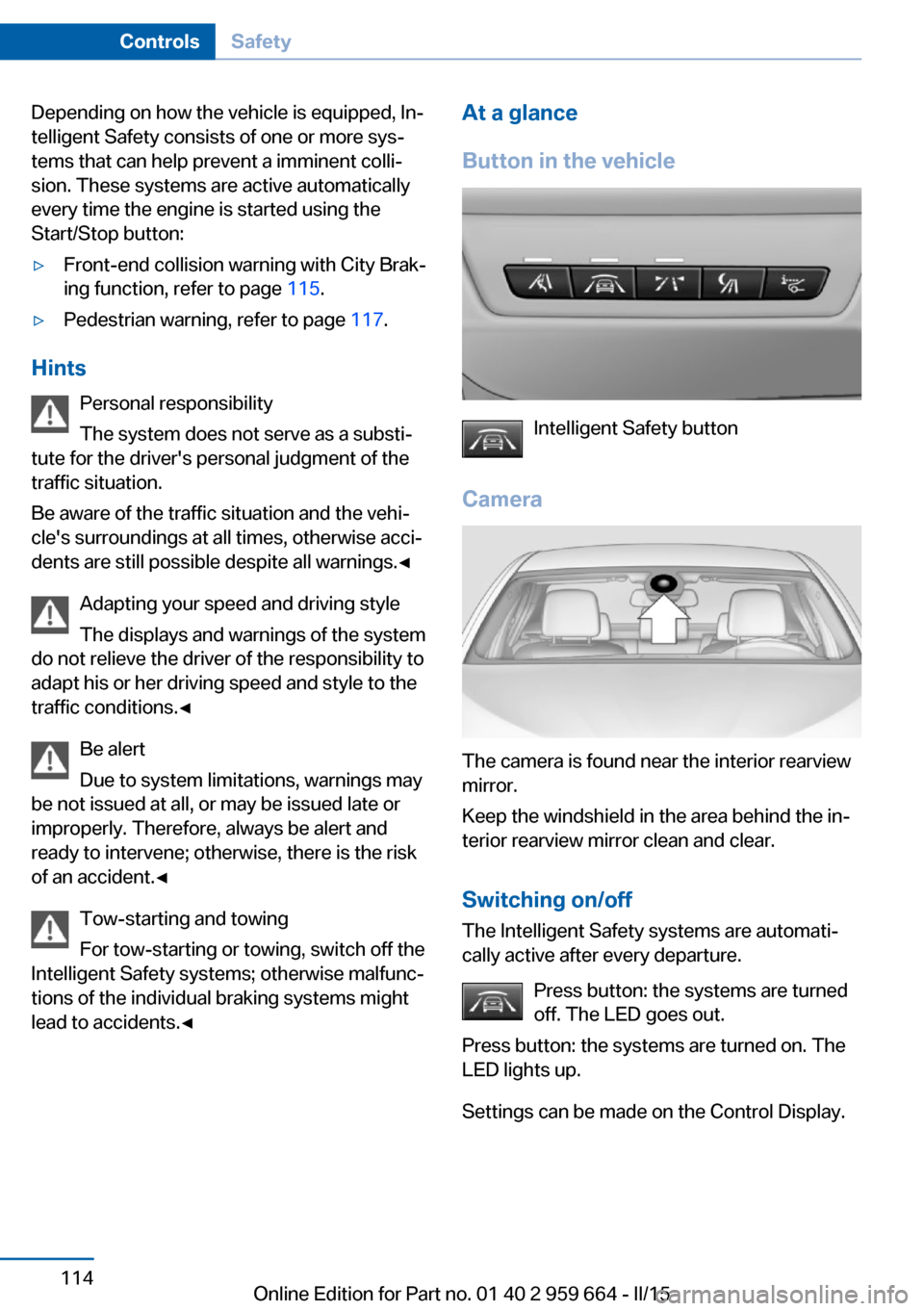
Depending on how the vehicle is equipped, In‚Äê
telligent Safety consists of one or more sys‚Äê
tems that can help prevent a imminent colli‚Äê
sion. These systems are active automatically
every time the engine is started using the
Start/Stop button:‚ñ∑Front-end collision warning with City Brak‚Äê
ing function, refer to page 115.‚ñ∑Pedestrian warning, refer to page 117.
Hints
Personal responsibility
The system does not serve as a substi‚Äê
tute for the driver's personal judgment of the
traffic situation.
Be aware of the traffic situation and the vehi‚Äê
cle's surroundings at all times, otherwise acci‚Äê
dents are still possible despite all warnings.‚óÄ
Adapting your speed and driving style
The displays and warnings of the system
do not relieve the driver of the responsibility to
adapt his or her driving speed and style to the
traffic conditions.‚óÄ
Be alert
Due to system limitations, warnings may
be not issued at all, or may be issued late or
improperly. Therefore, always be alert and ready to intervene; otherwise, there is the risk
of an accident.‚óÄ
Tow-starting and towing
For tow-starting or towing, switch off the
Intelligent Safety systems; otherwise malfunc‚Äê
tions of the individual braking systems might
lead to accidents.‚óÄ
At a glance
Button in the vehicle
Intelligent Safety button
Camera
The camera is found near the interior rearview
mirror.
Keep the windshield in the area behind the in‚Äê
terior rearview mirror clean and clear.
Switching on/offThe Intelligent Safety systems are automati‚Äê
cally active after every departure.
Press button: the systems are turned
off. The LED goes out.
Press button: the systems are turned on. The
LED lights up.
Settings can be made on the Control Display.
Seite 114ControlsSafety114
Online Edition for Part no. 01 40 2 959 664 - II/15
Page 119 of 230
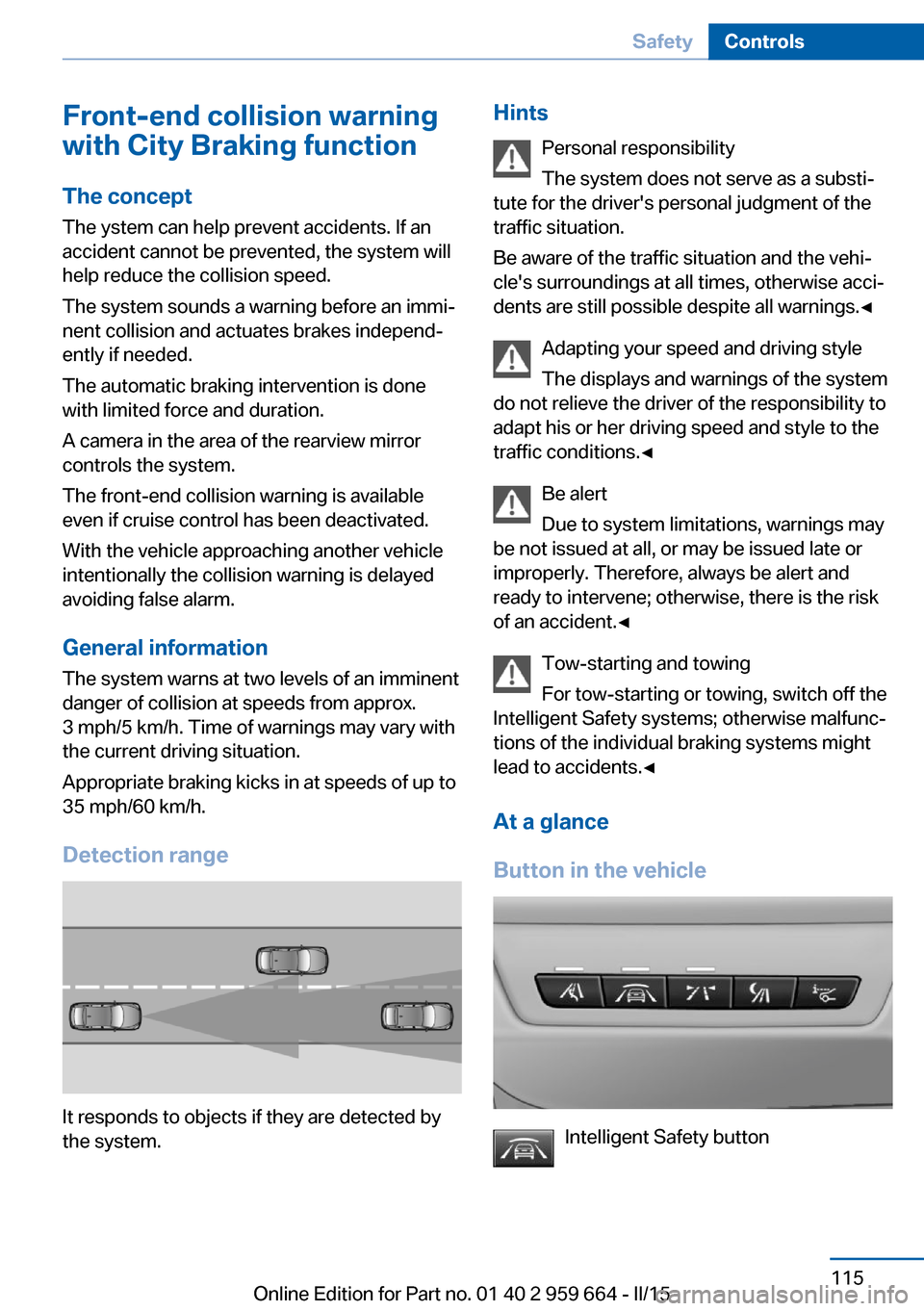
Front-end collision warning
with City Braking function
The concept The ystem can help prevent accidents. If an
accident cannot be prevented, the system will
help reduce the collision speed.
The system sounds a warning before an immi‚Äê
nent collision and actuates brakes independ‚Äê
ently if needed.
The automatic braking intervention is done
with limited force and duration.
A camera in the area of the rearview mirror
controls the system.
The front-end collision warning is available
even if cruise control has been deactivated.
With the vehicle approaching another vehicle
intentionally the collision warning is delayed
avoiding false alarm.
General information The system warns at two levels of an imminent
danger of collision at speeds from approx.
3 mph/5 km/h. Time of warnings may vary with
the current driving situation.
Appropriate braking kicks in at speeds of up to
35 mph/60 km/h.
Detection range
It responds to objects if they are detected by
the system.
Hints
Personal responsibility
The system does not serve as a substi‚Äê
tute for the driver's personal judgment of the
traffic situation.
Be aware of the traffic situation and the vehi‚Äê
cle's surroundings at all times, otherwise acci‚Äê
dents are still possible despite all warnings.‚óÄ
Adapting your speed and driving style
The displays and warnings of the system
do not relieve the driver of the responsibility to
adapt his or her driving speed and style to the
traffic conditions.‚óÄ
Be alert
Due to system limitations, warnings may
be not issued at all, or may be issued late or
improperly. Therefore, always be alert and ready to intervene; otherwise, there is the risk
of an accident.‚óÄ
Tow-starting and towing
For tow-starting or towing, switch off the
Intelligent Safety systems; otherwise malfunc‚Äê
tions of the individual braking systems might
lead to accidents.‚óÄ
At a glance
Button in the vehicle
Intelligent Safety button
Seite 115SafetyControls115
Online Edition for Part no. 01 40 2 959 664 - II/15